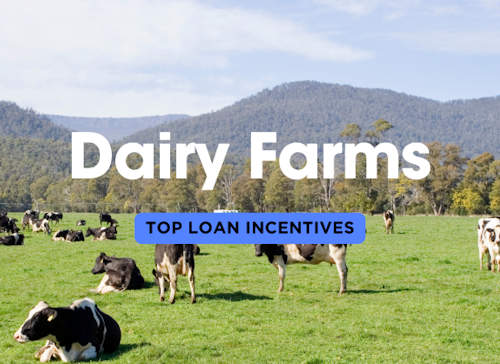Dairy farming requires significant capital to maintain operations, from purchasing livestock to upgrading equipment and facilities. To support this critical sector, various loan incentives are available to help farmers reduce costs, expand their operations, and adopt more sustainable practices. These incentives come in different forms, such as lower interest rates, flexible repayment terms, and even subsidies tied to environmentally friendly farming techniques. Below, we’ve outlined key loan incentives for dairy farms to help farmers maximize the benefits of available funding options.
| IncBook: Loan Incentives for Dairy Farms | ||||
|---|---|---|---|---|
| Incentive Program | Benefits | Loan Amounts | Eligibility Requirements | Drawbacks |
| USDA Farm Service Agency (FSA) Loans |
|
Up to $1.78 million |
|
|
| Environmental Quality Incentives Program (EQIP) |
|
Varies based on conservation project |
|
|
| State Agricultural Development Loans |
|
$100,000 – $1 million |
|
|
| Renewable Energy for America Program (REAP) |
|
Up to $500,000 |
|
|
| Young Farmer Loan Programs |
|
Up to $600,000 |
|
|
| Dairy Farm Modernization Grants |
|
Up to $250,000 |
|
|
| Farm Credit Cooperatives |
|
Up to $2 million |
|
|
Insider Tips
🐄 Optimize Equipment Financing for Robotic Milkers:
Robotic milking systems are becoming a game-changer in the dairy industry. When applying for a loan, emphasize how upgrading to a robotic milking system will reduce labor costs and increase efficiency. Banks and cooperatives often provide special incentives or lower interest rates for tech-driven upgrades that lead to long-term savings.
📊 Leverage Data from Milk Production Tracking Systems:
Many lenders want proof that your investment will pay off. Utilize milk production tracking systems to show consistent growth in your output and operational efficiency. By presenting this data, you can demonstrate that your farm is already on a path of optimization, which can lead to better loan terms or faster approval.
💧 Secure Funding with Environmental Impact in Mind:
Many dairy farms are moving toward more sustainable practices, and there are loan incentives specifically for eco-friendly operations. Highlight any manure management, waste recycling, or water conservation systems you’ve implemented. These eco-friendly upgrades not only qualify for programs like EQIP but may also attract state and local funding incentives.
📈 Use Future Dairy Contracts for Loan Negotiation:
If you have established contracts with dairy processors or buyers, these future revenue streams are gold when negotiating loan terms. Lenders are more likely to offer favorable terms if they know you have long-term buyers locked in, providing a steady cash flow. Make sure to emphasize these contracts in your loan application.
🌱 Bundle Conservation and Energy Grants Together:
Some of the best loan incentives come when you combine grants with loans. For instance, if you’re taking out a loan for barn upgrades, consider bundling that with renewable energy systems (solar panels, wind turbines, etc.). You could qualify for the Renewable Energy for America Program (REAP), which offers loan guarantees or grants for up to 25% of the project cost. This could lower your overall debt and energy expenses long term.
📝 Become a Member of a Farm Credit Cooperative:
Farm credit cooperatives offer more than just low-interest loans. By becoming a member, you can qualify for patronage dividends, which essentially reduce the amount you owe through profit-sharing. This incentive is often overlooked but can result in significant savings over the life of a loan. Always ask about patronage when considering cooperative loans.
🌾 Maximize Local Agricultural Development Programs:
Many states offer specific loan incentives for farms in agricultural development zones. If your farm is located in such an area, check for state-specific programs that offer partial loan forgiveness if you expand operations or create jobs in rural areas. Lenders love to see local involvement and rural development initiatives, which can result in more favorable terms.
📅 Time Your Loan Applications for Peak Production Seasons:
Dairy farming is cyclical, with peak production seasons providing more stable revenue. Lenders are more likely to offer better terms during or just after these peak seasons because your income is more predictable. Plan your loan applications to coincide with your strongest financial period, and use seasonal data to support your application.
🌍 Apply for Carbon Credit Programs Alongside Loan Requests:
Many farms are now eligible for carbon credit programs due to their sustainable practices. If you’ve adopted carbon-saving techniques, such as methane digesters or low-emission manure management, you can qualify for carbon credits that reduce operational costs. Lenders often view this as a low-risk investment since it creates additional revenue streams. Highlight this in your loan applications to secure better terms.
🚜 Finance Through Specialized Dairy Equipment Vendors:
Some dairy equipment vendors offer in-house financing at lower rates than traditional banks. These loans often come with deferred payments, allowing you to begin repayment once your equipment is fully operational. If you’re upgrading milking systems or installing automatic feeders, inquire about vendor financing and compare it with bank loans to find the best deal.
Additional References
USDA Farm Service Agency (FSA) – Farm Loan Programs
https://www.fsa.usda.gov/programs-and-services/farm-loan-programs/index
This page provides detailed information on various loan programs offered by the USDA FSA, including loans targeted at beginning farmers, operating loans, and microloans designed for agricultural development, including dairy farms.
Environmental Quality Incentives Program (EQIP)
https://www.nrcs.usda.gov/wps/portal/nrcs/main/national/programs/financial/eqip/
EQIP offers financial and technical assistance to farmers implementing conservation practices, including those in the dairy industry. This site outlines how to apply for funding and the specific projects eligible for cost-sharing.
Renewable Energy for America Program (REAP)
https://www.rd.usda.gov/programs-services/energy-programs/renewable-energy-systems-energy-efficiency-improvement-guaranteed-loans
The REAP program offers loan guarantees and grants to help dairy farms install renewable energy systems and improve energy efficiency, reducing long-term operational costs. This page contains details on eligibility and how to apply.
National Sustainable Agriculture Coalition – Federal Loan Programs
https://sustainableagriculture.net/publications/grassrootsguide/credit-crop-insurance/federal-loan-programs/
This guide outlines various federal loan programs available to dairy and other farmers, with a focus on sustainable agricultural practices. It covers loan types, eligibility criteria, and benefits for small and mid-sized farmers.
Farm Credit System – Loans for Agriculture
https://farmcredit.com/loan-options/agriculture
The Farm Credit System is a nationwide network of cooperative lenders that specialize in providing loans for agricultural businesses, including dairy farms. This page provides an overview of the loan options available, including operating loans, equipment financing, and real estate loans.



